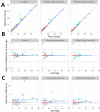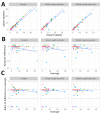Performance evaluation of human cough annotators: optimal metrics and sex differences
- PMID: 37945314
- PMCID: PMC10649781
- DOI: 10.1136/bmjresp-2023-001942
Performance evaluation of human cough annotators: optimal metrics and sex differences
Abstract
Introduction: Despite its high prevalence and significance, there is still no widely available method to quantify cough. In order to demonstrate agreement with the current gold standard of human annotation, emerging automated techniques require a robust, reproducible approach to annotation. We describe the extent to which a human annotator of cough sounds (a) agrees with herself (intralabeller or intrarater agreement) and (b) agrees with other independent labellers (interlabeller or inter-rater agreement); we go on to describe significant sex differences in cough sound length and epochs size.
Materials and methods: 24 participants wore an audiorecording smartwatch to capture 6-24 hours of continuous audio. A randomly selected sample of the whole audio was labelled twice by an expert annotator and a third time by six trained annotators. We collected 400 hours of audio and analysed 40 hours. The cough counts as well as cough seconds (any 1 s of time containing at least one cough) from different annotators were compared and summary statistics from linear and Bland-Altman analyses were used to quantify intraobserver and interobserver agreement.
Results: There was excellent intralabeller (less than two disagreements per hour monitored, Pearson's correlation 0.98) and interlabeller agreement (Pearson's correlation 0.96), using cough seconds as the unit of analysis decreased annotator discrepancies by 50% in comparison to coughs. Within this data set, it was observed that the length of cough sounds and epoch size (number of coughs per bout or attach) differed between women and men.
Conclusion: Given the decreased interobserver variability in annotation when using cough seconds (vs just coughs) we propose their use for manually annotating cough when assessing of the performance of automatic cough monitoring systems. The differences in cough sound length and epochs size may have important implications for equality in the development of cough monitoring tools.
Trial registration number: NCT05042063.
Keywords: Cough/Mechanisms/Pharmacology.
© Author(s) (or their employer(s)) 2023. Re-use permitted under CC BY-NC. No commercial re-use. See rights and permissions. Published by BMJ.
Conflict of interest statement
Competing interests: MR, JCG, RM, LJ, MG and PS were or are employees of Hyfe and own equity in Hyfe. CCh has received consultancy fees and owns equity in Hyfe. All other authors declare no conflict of interest.
Figures










Similar articles
-
Automatic Recognition, Segmentation, and Sex Assignment of Nocturnal Asthmatic Coughs and Cough Epochs in Smartphone Audio Recordings: Observational Field Study.J Med Internet Res. 2020 Jul 14;22(7):e18082. doi: 10.2196/18082. J Med Internet Res. 2020. PMID: 32459641 Free PMC article.
-
How to count coughs? Counting by ear, the effect of visual data and the evaluation of an automated cough monitor.Respir Med. 2014 Dec;108(12):1808-15. doi: 10.1016/j.rmed.2014.10.003. Respir Med. 2014. PMID: 25458158
-
Establishing a gold standard for manual cough counting: video versus digital audio recordings.Cough. 2006 Aug 3;2:6. doi: 10.1186/1745-9974-2-6. Cough. 2006. PMID: 16887019 Free PMC article.
-
Monitoring chronic cough: current and future techniques.Expert Rev Respir Med. 2010 Oct;4(5):673-83. doi: 10.1586/ers.10.63. Expert Rev Respir Med. 2010. PMID: 20923344 Review.
-
Objective assessment of cough.Eur Respir J. 1995 Nov;8(11):1949-56. doi: 10.1183/09031936.95.08111949. Eur Respir J. 1995. PMID: 8620968 Review.
Cited by
-
Chronic cough: symptom, sign or disease?ERJ Open Res. 2024 Aug 5;10(4):00449-2024. doi: 10.1183/23120541.00449-2024. eCollection 2024 Jul. ERJ Open Res. 2024. PMID: 39104960 Free PMC article.
References
Publication types
MeSH terms
Associated data
LinkOut - more resources
Full Text Sources
Medical
